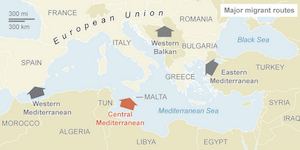SUBOTICA, Serbia -- With war continuing to plague the Middle East and Afghanistan, and thousands trying to flee Africa's grinding poverty, the swell of refugees and others hoping to reach Western Europe shows no signs of abating this summer.
For the past few years, the most popular route has been across the Mediterranean on boats run by Libyan smugglers that aimed for the nearest islands off the Italian coast. But as that route has become increasingly dangerous -- the threats include drowning, abandonment by smugglers and crackdowns by European border patrols -- the human tide is shifting. Increasingly, people are following a land-based route into Europe by way of Greece and the West Balkans.
But with the alternative crossing come other perils: violence, exploitation, intolerance. Though most European countries are overwhelmed by the tide, fueling an anti-migrant backlash in many places, Eastern European countries like Hungary, Serbia and Bulgaria are considered particularly hostile.
Still, the people keep arriving.
Near an abandoned brick factory in Subotica, Serbia, between 150 and 200 people -- mostly men, with a smattering of young families -- cluster in groups in scattered campsites.
"We have people from Iraq, Pakistan, Iran, Afghanistan, Eritrea, Somalia, Morocco," said Mohamd, 42, a former truck driver for a factory near Aleppo, Syria, who hopes to reach the Netherlands.
Mohamd, like more than two dozen people interviewed at the brick factory and other sites along the Serbian border with Hungary, declined to give his last name for fear of reprisals against relatives left behind and unwelcoming authorities on the road ahead.
He left Syria on May 16, made his way through Turkey and slipped across the border into Greece. His was a typical story.
Along the way, there may be short bus rides or miles covered by train. But for many of the people, the journey is largely undertaken on foot. They follow rail lines or paths passed along by smugglers or passed down the communications chain from refugees farther ahead.
The journey from Aleppo, Syria, to Szeged, Hungary's third-largest city, is 1,100 miles on a direct route, but more than 1,500 miles by road, and more than that to skirt checkpoints and follow forest paths and railbeds.
"I took a few short trains and a bus," Mohamd said. "But mostly, we walked."
It took 10 days to get through Greece. Macedonia was crossed quickly, but he has been stuck in Serbia for a month. Twice he had sneaked into Hungary and was quickly arrested, spending 16 days in jail the first time and five the next. He also earned an official document that bans him from entering the country for three years.
"I will try again either tonight or tomorrow," he said, shrugging. "What else can I do? There is no life anymore in Syria, only bombing."
In a report this month by Amnesty International, the organization acknowledged the dangers of the land route. "Refugees face considerable obstacles in accessing asylum in any country along their journey," the report said.
"Refugees and migrants alike are at constant risk of exploitation, arbitrary detention and ill treatment."
The Hungarian town of Asotthalom sits at the point where the national highway dips closest to the border, not far from the brick factory. Its mayor, Laszlo Toroczkai, a former activist in an anti-Semitic youth group who has since joined the rightist Jobbik party, has drawn national attention for his opposition to the human tide.
"I really respect Islam," he said, seated in his office in the Town Hall. "But Europe is not a continent of Islam. That's why we fought them in the Middle Ages: to get them out."
While Hungary has a responsibility to care for genuine refugees, he said, he believes that many crossing into Hungary are just illegal migrants angling for a better life in a more open society.
Toroczkai is credited with first proposing the idea of building a fence along Hungary's entire border with Serbia, which stretches more than 100 miles -- something the government has begun to do.
In the small Serbian town of Kanjiza, several miles east of Subotica, a slightly more affluent cluster of travelers gathered in a park beside the bus depot.
The walk across the border to Szeged is just 20 miles.
Many of them said they still had enough money to sleep in hotels and pay premium prices to trusted smugglers.
Annas, 26, a mechanical-engineering student from Damascus, took shelter in the stifling shade. "The Syrian military wanted to take me for military service," he said, "so I escaped."
Serbian gangs stalk small groups of people in the borderlands, he said.
"If you are just four or five, you lose everything. That is why we travel in groups of 50."
He described the plan: They would leave in less than an hour and try to arrive in Szeged shortly after midnight. A certain taxi stand is known to have cars waiting every night between 3 and 5 a.m. to drive anyone with $110 the two hours north to Budapest, no questions asked.
From there, minivans would continue the journey into Germany for another $440 a person.
"It is possible if you know where to go and you have enough money," Annas said.
A Section on 07/26/2015

